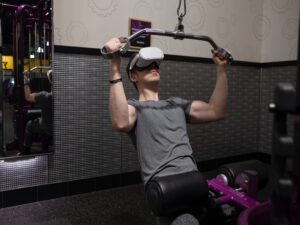If you are in search of exercise for the lower part of your body and want to know about Lunge Work What Muscles this article is a complete guide about it. The lunge includes the body’s lower muscles, this training exercise strengthens and built your muscles, over and above refining their ability with muscle mass. It also helps to burn calories and increase heart rate. If you want to improve your body functionality, and core strength and give a better shape to your legs, add it to your daily workout. This lower-body workout does not seem impressive as a deadlift or squat but it’s a good source of a powerhouse for our body. You can make this work out more challenging by adding some variations. This article will also cover how to do a lunge, common mistakes while doing this workout, who can do a lunge, and the proper steps to enjoy its benefits.
What is lunge
It’s a popular resistance exercise to strengthen your body. The main target is the gluteus, legs, and calves. A lunge is a compound movement of the lower part of your body. In which you step forward and flex the knee joint making angle of 90 degrees. After pressing back legs to bilateral stand tall. It’s like a contraction and balancing of the legs, including the glute muscles. Building lower body mass and strength. This is an interesting workout but causes certain injuries by doing it improperly. Therefore, it’s better not to try to master the technique until getting expertise in the normal lunge. During the workout keep your knee track over the second and third toes. Later on, add weight like dumbbells, that gonna add stability to your quads, hamstring, and core.
Phases of lunge
There are not any specific phases but on the bases of the muscles movement we have divided it into three phases:
- Eccentric
- Concentric
- Plane movement
Let’s have a brief discussion of these movements will help you to understand lunge work what muscles.
Eccentric
It’s a triple flexion move that includes the hip, knee, and ankle, also known as the acentric phase. In the lunge position, these three joints should be equally extended and bring the body back to its anatomical position. For the flexion of the lower body Including gluteus muscles, biceps, semimembranosus, and psoas must contract. This contraction of the muscles is isometric.
Concentric
After getting back to the anatomical position in which the toe and body face forward and the legs are apart as the hip width. This is the primary extension that is vital while moving back to the standing position. The quadriceps are the main muscle of knee extension and bring the lugged leg to the normal position.
Plane movement
As we know in the eccentric and concentric phases there is flexion and extension of muscles respectively. Now when the plane movement or phase comes it’s a body relaxation phase, the anatomical posture. The body is motionless in static equilibrium, external pressure ad torque sum is zero.
- Eccentric movement is slow because there is flexion of the glutes and concentric is power movements to get back to a standing position.
Lunge Work What Muscles
Prime targets of the lunge are the glutes, quads, and hamstring. Furthermore, this workout includes abductors and erectors to help them to stabilize. You can perform a lunge with different variations.
Glutes
Glutes are thigh and butt muscles. When arms and torso (part of the body that connects the lower part and extremities of the body) lean in the opposite direction of the lunge, activate glute muscles. As well front push-ups strengthen the hip and knees because the glute medius stabilizes them.
Quads
Control movements of ascent and descent quads also activate. Quads work hard like glutes you can feel crucially in the legs when doing lunge pushups.
Hamstring
While moving from forward to reverse lunge, means coming back to a standing position demands output of the hamstring helping your knees to stabilize.
Abductors
The abductors are the inner thighs, in the lunge, it works as a stabilizer of the thigh by keeping it in the midline and holding the knee.
How to do lunge properly
Before starting a workout few things, you have to keep in mind are: keeping hips, shoulders, and knees in a straight line, meanwhile in a bending position knee should make an angle of 90 degrees. When a lunge initiate it is supposed to feel movement in the legs, hamstring, and glutes or if not then gently modify your foot position.
Now come to the main point of how to execute lunge step-wise:
- Stand in the position of keeping your foot apart at the same hip-width.
- Then bend your knee, keeping your shine vertical making an angle of 90 degrees. Holding legs and shoulders in a straight line.
- Rise your back heel with your big toe and keep your front foot flat on the ground.
- Then keep your torso upright and core tight.
- Back to the starting position by forcefully pushing off.
- Switch your legs to interchange side lunge.
- 10 laterals are enough for beginners.
Benefits of the lunges
From the above discussion it is clear that lunge is a muscular exercise, moreover negotiating its benefit make it more clear about lunge works what muscles. Lunge works for stability, balancing, and strengthening tight as well as shaping the cellulite. Cut the line and dig into it.
- Doing side lunges, sort of twisting or forward movement working on the quadriceps, glutes, and legs gives your body a nice change. In addition, activation of muscle.
- Static lunge with forward lunge is the best medication for people who have knee or joint pain. It’s a split squat wherein there Is no step out or return necessitate.
- Curtsy lunge sculpts the hip adductors, quadriceps, and hamstrings to enhance its stability.
- Adding weight like dumbbells in your workout, support the trunk putting pressure on gluteal and oblique muscles.
Conclusion
A lunge is a beneficial workout for both beginners and gym enthusiasts. You can learn it easily and add it to lower body exercises to get strong quads and gluteal. This article concludes with the answer of Lunge Work What Muscles plus how to do it properly.

